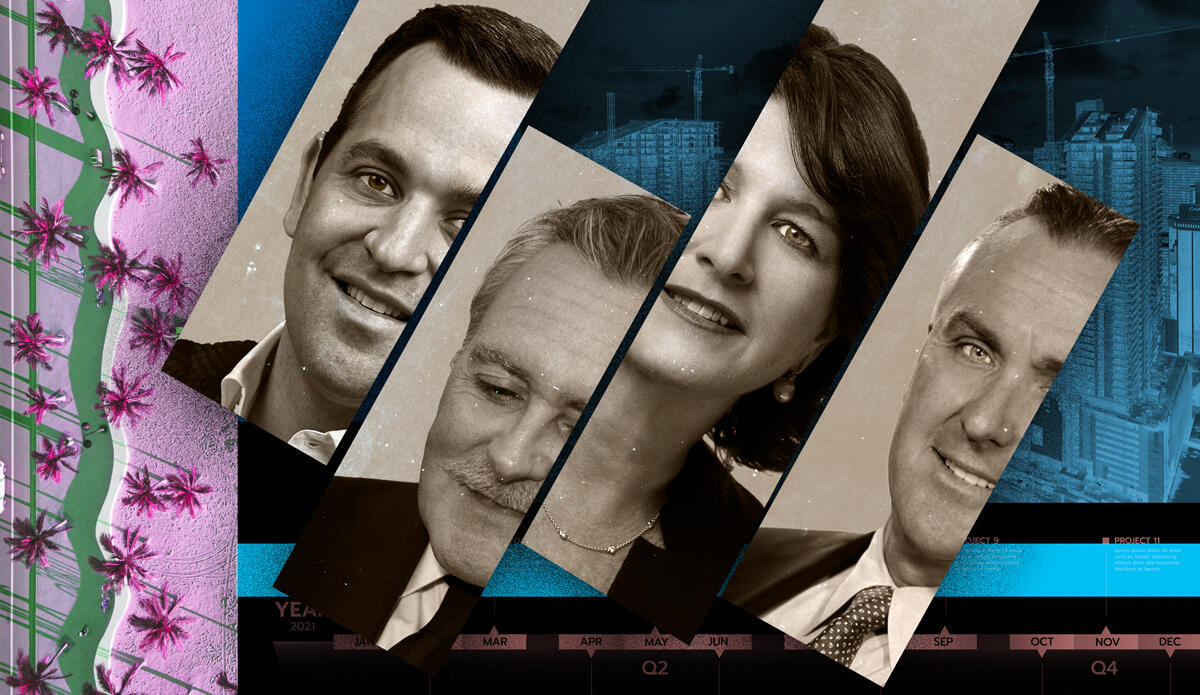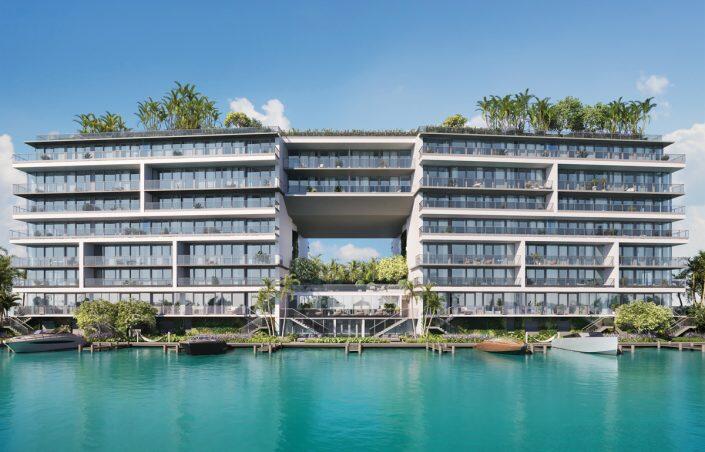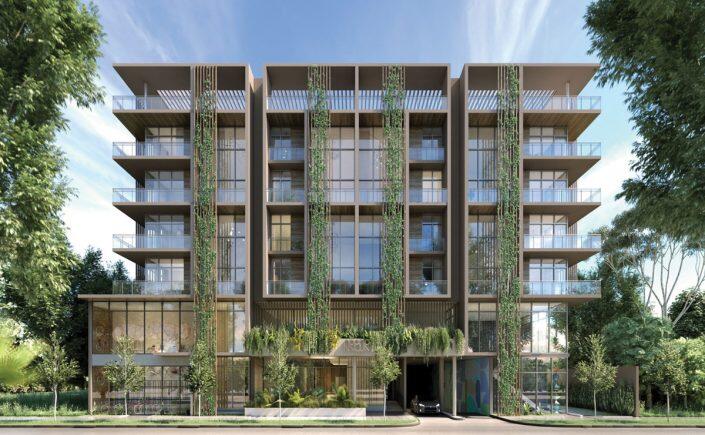
On a tree-lined street north of downtown Coconut Grove, a boutique condo building sits unfinished. The windows and doors are in, but the ground floor is just dirt and rocks. Faded notes of missed deliveries are stuck to the exterior.
It’s a far cry from what the marketing materials promised: a sleek, glassy building with vines that hang from the roof down to the first floor. The project was supposed to be delivered in 2019.
The 50-unit development, called Arbor Residences, is at the center of a foreclosure lawsuit filed by its lender, Trez Capital. In August, the developer, Nick Hamann, said he was working to refinance the loan and complete the project, but by October, Trez Capital sold the note to another developer. Meanwhile, condo buyers are stuck in limbo, unable to close on their units.
Arbor illustrates what can happen when budgets go awry, a scenario that’s increasingly becoming reality. Although industry leaders insist that the South Florida market is immune to collapse, developers across the region are grappling with the rising cost of nearly everything: labor, land, materials and, more recently, debt and insurance.
To entice lenders, or even buyers, some developers are seeking equity partners. Others are waiting for costs to level out or negotiating with banks to secure construction financing. Many land deals are on hold or have fallen apart. But developers continue to launch new projects or revive old ones.
“Now what we’ll be seeing is more people investing money in existing projects, not just land,” said Suzanne Amaducci-Adams, head of the real estate practice at Bilzin Sumberg. “The beginning of this cycle is for deals to die and settle out, and people will start putting deals together in a different way.”
Cuffing season
About five miles away from Arbor, Shahab Karmely has been sitting on a waterfront site along the Miami River, where he first revealed plans for One River Point in 2014. The planned luxury condo development, designed by architect Rafael Viñoly, calls for two towers connected by a three-story glass skybridge and an 85-foot waterfall. It was slated for completion in 2018.
The project was stalled until last fall, when Karmely’s KAR Properties sold a joint-venture interest in the 386-unit project to Edgardo Defortuna. The two are now working on “softening” the design and modifying the floor plans. They’ll relaunch sales within six months, Karmely said.
Karmely cited Defortuna’s track record and his ability to write a check. Shortly after securing Defortuna’s Fortune International Group as a partner, the two closed on a $38 million loan from Bank OZK — a line of credit the developers are using for sales, marketing and other pre-development planning.
Defortuna’s firm led sales and marketing of KAR Properties’ 2000 Ocean condo in Hallandale Beach, and the two teamed up to buy out the remaining units at Swire Properties’ Brickell City Centre.

La Baia in Bay Harbor Islands (Evolution Virtual)
“It’s not taking anything away from me to say Edgardo has greater legitimacy in this market,” Karmely said.
Farther north, Jorge Pérez’s Related Group recently joined the development team behind the Bahia Mar mixed-use project in Fort Lauderdale, which has been in the works since 2014. Related entered a joint venture with developers Jimmy Tate and Sergio Rok to get the ball rolling on the $1 billion-plus waterfront redevelopment, which includes 60 luxury condos.
Karmely compared developers seeking additional equity partners or co-developers to a successful marriage — they’re stronger together than apart.
“Some people [seek partners] because they want to de-lever risk,” he said. “Some want to increase their footprint in a market, [and] some because they want to decrease their footprint in a market.”
The surge
In some cases, the cost of construction insurance has gone up more than 40 percent year-over-year, said Fred Zutel, who heads property and casualty at insurer Lockton Companies.
Developers of new projects are now forced to seek the same amount or even less coverage from a greater number of insurers, at a higher cost.
Developers may secure less coverage if their lender allows it, or they may make design changes to lower the risk, thus lowering the cost of insurance, Zutel said. One example of the latter scenario is removing an underground garage in a waterfront project and instead building a parking podium.
The more elaborate a project, the riskier and more expensive it becomes.
One complicating factor is the increase in such disasters as Hurricane Ian. That storm largely spared South Florida, but it wreaked havoc on parts of west and central Florida when it made landfall in September.
“Hurricane Ian has caused significant turmoil in the insurance market,” Zutel said. “As those claims are paid, there is a churning effect, especially with builders’ risk insurance.”
Still, Zutel said he hasn’t heard of insurance alone killing a deal.
“I don’t know that it discourages development,” he said, “but developers not paying attention to this are at a disadvantage.”
Ian Bruce Eichner, who recently bound a policy for La Baia, a luxury condo project in Bay Harbor Islands, agreed.
“It was more expensive than we budgeted,” said Eichner, of Continuum Company. “That does not start or stop a project. What makes a difference is when your construction costs have increased 20, 25 percent.”
The cost of some materials, including lumber, fell dramatically from their pandemic peaks, but other materials, labor and logistical costs are still growing or experiencing volatility. The price of lumber fell to less than half of where it was a year ago. Other items, such as elevator switchgear, are also still backlogged, Eichner said, forcing developers to order those up to 18 months in advance.

Arbor Residences in Coconut Grove
Tom C. Murphy, co-president of Coastal Construction, said that the costs of some materials have stabilized, but others, like concrete, continue to increase.
“The transportation of those materials and the labor to install them, that’s really where the prices will continue to go up,” Murphy said.
The influx of out-of-state developers during the pandemic propelled land prices to new highs, forcing brokers and local builders to question the feasibility of some projects.
Those who are likely facing the most trouble are the developers who “came to the game late,” Murphy said, and overpaid for a site “not fully knowing what they could do with it.”
Former Related Group executive Carlos Rosso, whose projects include the Standard Residences in Midtown Miami and One Park Tower at SoLé Mia in North Miami, said land prices have not come down.
“It’s the Citadel effect,” he said, referring to hedge funder Ken Griffin paying $363 million, or $3,340 a square foot, for a waterfront parking lot in Brickell. “Suddenly, Genting wants $1 billion for a site.” (Genting, the Malaysian gambling operator, is looking to sell a 15-plus-acre waterfront assemblage in downtown Miami for more than $1 billion, sources confirmed to The Real Deal in November.)
Eichner, who recently began selling the second phase of La Baia, said there’s been a “noticeable slowing of the pace of sales for all condo developments.”
Demand is nothing like it was a year ago, he said. “It’s a different market.”
Cold front
In the fall, Related, Miami’s most prolific developer, shrunk one luxury condo project and pulled out of a proposed buyout of an older complex it sought to redevelop. The firm eliminated the less expensive tower at the planned St. Regis Residences, Miami, a project it’s working on with Integra Investments.
Related claims that the change was driven by buyers in the more expensive building seeking more exclusivity, but some sources said that prospective buyers had actually been canceling their reservations in the since-eliminated tower.
Around the same time, Related and Arnaud Karsenti’s 13th Floor Investments pulled out of a proposed $500 million condo buyout of an older tower in Miami Beach, which the two firms would have redeveloped.
In addition to development being more expensive, demand and the pace of sales have slowed compared to the frenzy seen in 2021 and early 2022. Jon Paul Pérez, Jorge’s son and president of Related, is among the developers who say the market is healthier as a result. The firm is expected to launch sales of additional projects this year.
“When people compare today’s market to a year or year and a half ago, it was an anomaly,” he said. “Things were selling at whatever price, instantly. It was not a normal market.”
Pérez said that most projects Related has already launched, with the exception of more recent ones such as Rivage in Bal Harbour, are sold out or mostly sold out. Those in the reservations stage — before buyers are in contract — are 40 to 60 percent presold.
“We’re still having additional sales. One week we’ll have 10 sales, another week we’ll have two,” Pérez said.
Some sources said that the slowdown, coupled with budgets that no longer pan out, will result in newer projects being completed later than initially marketed. Others insist there has always been a disconnect between the completion date on a marketing brochure and the date on a contract.
Craig Studnicky, CEO of the brokerages ISG World and Related ISG, said today’s buyer pool — domestic buyers planning to relocate to South Florida full-time — is less willing to put up with changing timelines.
“Buyers can’t afford to wait. You need to know when the hell you’re going to be able to move in,” Studnicky said. “It’s becoming a problem for the developers.”
Phil Gutman, a broker whose projects include Eichner’s La Baia, said some completion dates have been moved back in order for developers to account for other delays that could generate additional interest on construction loans. But he said that the bigger issue is that some projects were presold based on a now-unrealistic price-per-foot cost.
“The profit margins aren’t going to be what they anticipated,” Gutman said, “but most developers are going to absorb the increases.”
Some have not. Despite high presales, Chilean firm Ambienta Developers wasn’t able to begin construction on its Bay Harbor Islands condo project after construction costs jumped and it was unable to secure financing. Alta Developers took over the project last year, returning deposits to buyers and launching a new version of the development.
But those situations are, for now, few and far between. Developers are more likely to seek equity infusions from new partners, especially as construction loans remain extremely challenging to secure, said Amaducci-Adams, the real estate attorney.
“The concept of preferred equity will become much more prevalent this year,” she said.
